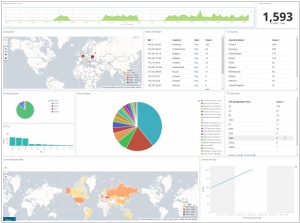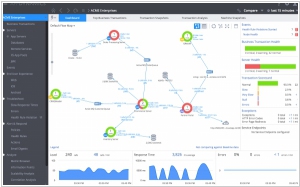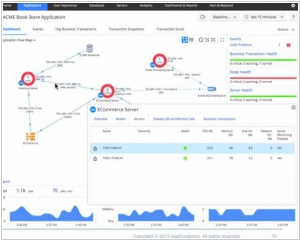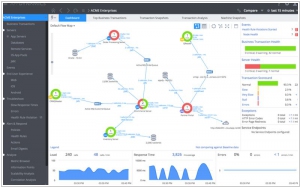AppDynamics vs ELK
January 25, 2017 | Author: Michael Stromann
13

ELK is the acronym for three open source projects: Elasticsearch, Logstash, and Kibana. Elasticsearch is a search and analytics engine. Logstash is a server‑side data processing pipeline that ingests data from multiple sources simultaneously, transforms it, and then sends it to a "stash" like Elasticsearch. Kibana lets users visualize data with charts and graphs in Elasticsearch.
AppDynamics and ELK (Elasticsearch, Logstash, and Kibana) are two different types of tools used in the field of software monitoring and observability. While they share some similarities, there are several key differences between the two:
Functionality: AppDynamics is a comprehensive application performance monitoring (APM) solution that provides end-to-end visibility into the performance and health of applications and their underlying infrastructure. It offers features such as application and infrastructure monitoring, real-time transaction tracing, code-level diagnostics, analytics, and alerting. On the other hand, ELK is a set of open-source tools used for log management and analysis. Elasticsearch is a distributed search and analytics engine, Logstash is a data ingestion and processing tool, and Kibana is a data visualization and dashboarding tool. ELK is primarily focused on log and event data collection, processing, and analysis.
Scalability and Flexibility: AppDynamics is a commercial tool and typically used in enterprise environments, with features designed for scalability and flexibility. It supports monitoring of complex applications with distributed architectures and provides extensive instrumentation for various programming languages and frameworks. ELK, being open-source, offers flexibility in terms of customization and can be used in a wide range of environments. It can scale horizontally to handle large volumes of log data and can be integrated with other tools and systems in the software stack.
Ease of Use: AppDynamics provides a user-friendly, GUI-based interface for monitoring and managing applications, making it relatively easy to set up and use. It offers automatic discovery and monitoring of applications and infrastructure components, and provides pre-built dashboards and alerts. ELK, being a set of open-source tools, may require more setup and configuration, and may involve a steeper learning curve for users who are not familiar with the technologies.
Pricing: AppDynamics is a commercial tool and typically requires a paid license, with different pricing tiers based on the features and capabilities needed. ELK, on the other hand, is open-source and free to use, although there may be associated costs for hosting, managing, and supporting the tool in production environments. There are also paid support options available from the company behind the ELK stack, Elastic.
Ecosystem and Integration: AppDynamics offers a comprehensive ecosystem of integrations with various third-party tools, platforms, and cloud services, including popular APM frameworks, databases, message brokers, and cloud providers. ELK, being a set of open-source tools, also offers a wide range of integrations and plugins, but may require more custom development and configuration for specific use cases.
It's important to consider the specific requirements and goals of your monitoring and observability needs, as well as the budget and resources available, when evaluating the differences between AppDynamics and ELK. Both tools have their strengths and are suitable for different use cases and environments.
See also: Top 10 IT Monitoring software
Functionality: AppDynamics is a comprehensive application performance monitoring (APM) solution that provides end-to-end visibility into the performance and health of applications and their underlying infrastructure. It offers features such as application and infrastructure monitoring, real-time transaction tracing, code-level diagnostics, analytics, and alerting. On the other hand, ELK is a set of open-source tools used for log management and analysis. Elasticsearch is a distributed search and analytics engine, Logstash is a data ingestion and processing tool, and Kibana is a data visualization and dashboarding tool. ELK is primarily focused on log and event data collection, processing, and analysis.
Scalability and Flexibility: AppDynamics is a commercial tool and typically used in enterprise environments, with features designed for scalability and flexibility. It supports monitoring of complex applications with distributed architectures and provides extensive instrumentation for various programming languages and frameworks. ELK, being open-source, offers flexibility in terms of customization and can be used in a wide range of environments. It can scale horizontally to handle large volumes of log data and can be integrated with other tools and systems in the software stack.
Ease of Use: AppDynamics provides a user-friendly, GUI-based interface for monitoring and managing applications, making it relatively easy to set up and use. It offers automatic discovery and monitoring of applications and infrastructure components, and provides pre-built dashboards and alerts. ELK, being a set of open-source tools, may require more setup and configuration, and may involve a steeper learning curve for users who are not familiar with the technologies.
Pricing: AppDynamics is a commercial tool and typically requires a paid license, with different pricing tiers based on the features and capabilities needed. ELK, on the other hand, is open-source and free to use, although there may be associated costs for hosting, managing, and supporting the tool in production environments. There are also paid support options available from the company behind the ELK stack, Elastic.
Ecosystem and Integration: AppDynamics offers a comprehensive ecosystem of integrations with various third-party tools, platforms, and cloud services, including popular APM frameworks, databases, message brokers, and cloud providers. ELK, being a set of open-source tools, also offers a wide range of integrations and plugins, but may require more custom development and configuration for specific use cases.
It's important to consider the specific requirements and goals of your monitoring and observability needs, as well as the budget and resources available, when evaluating the differences between AppDynamics and ELK. Both tools have their strengths and are suitable for different use cases and environments.
See also: Top 10 IT Monitoring software
AppDynamics vs ELK in our news:
2017. Cisco aquired application performance management software AppDynamics

Cisco has made a significant acquisition by purchasing AppDynamics for a remarkable $3.7 billion. AppDynamics specializes in providing performance monitoring solutions for business applications, allowing customers to gain valuable insights into the inner workings of their applications. This comprehensive overview enables companies to effectively identify bottlenecks and performance issues that may hinder transactions and other actions. The primary objective is to detect and address potential issues before they escalate into major problems, sparing companies significant headaches. With this acquisition, Cisco further expands its range of offerings and provides companies with a more comprehensive stack of tools to support their business operations.
2015. AppDynamics allows to track business transaction from user to server

AppDynamics, a company specializing in app and website monitoring to prevent outages and facilitate efficient recovery, has announced a significant update. The latest version introduces enhanced capabilities for identifying both major and minor issues that can negatively impact user experiences on apps or websites. It specifically aims to assist customers in recognizing patterns such as multiple individuals encountering problems with the shopping cart on an eCommerce site or tracking an individual customer's 'digital journey' while utilizing a mobile app or browsing the company's website. The ultimate objective is to pinpoint performance issues at any stage of the user's interaction.
2015. Application performance management provider AppDynamics raises $158M

San Francisco-based company AppDynamics has successfully concluded a funding round, raising a total of $158 million. The round was led by General Atlantic and Altimeter Capital. AppDynamics specializes in developing software that monitors the performance of business applications. It competes with established firms like IBM, as well as newer players such as New Relic, which went public in December of the previous year and has demonstrated relatively consistent stock performance since then. (New Relic, which secured $214 million in venture funding, currently boasts a market capitalization of $1.8 billion.) AppDynamics had previously secured approximately $206 million in debt and equity financing, which includes a $120 million round—comprised of $70 million in equity and $50 million in debt—that concluded in July of the preceding year.



